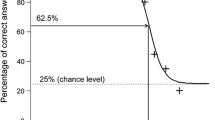Abstract
From 354 visual fields of 137 normal subjects, various components of variance were calculated separately for each test location of the Octopus automated-perimetry program JO. The method of component analysis of variance was used. The following components were analyzed: interindividual variation (variation of visual-field measurements in different subjects), long-term fluctuation (variation of different visual-field measurements in the same subject), differences between the right and left eyes and fluctuation within one visual field test in one subject, i.e., short-term fluctuation. The results show increased variations at the center relative to the paracentral area and a slight increase with eccentricity.
Similar content being viewed by others
References
Bebié H, Fankhauser F, Spahr J (1976) Static perimetry: accuracy and fluctuations. Acta Ophthalmol 54:339–348
Drance SM, Berry BA, Hughes RN (1966) Studies in the reproducibility of visual field areas in normals and glaucomatous subjects. Can J Ophthalmol 1:14–19
Flammer J (1985) Fluctuations in the visual field. In: Drance SM, Anderson DR (eds) Automated perimetry in glaucoma: a practical guide. Grune and Stratton, Orlando, pp 161–173
Flammer J (1985) Normal values in computerized perimetry. In: Whalen WR, Spaeth GL (eds) Computerized visual fields. Slack, Thorofare, pp 159–164
Flammer J, Drance SM, Schulzer M (1983) The estimation and testing of the components of long-term fluctuation of the differential light threshold. Doc Ophthalmol Proc Ser 35:383–389
Flammer J, Drance SM, Zulauf M (1983) Differential light threshold; short-and long-term fluctuation in patients with glaucoma, normal controls and patients with suspected glaucoma. Arch Ophthalmol 102:704–706
Gloor BP (1982) Die Computerperimetrie in der langfristigen Beurteilung des Glaukoms. In: Krieglstein GK, Leydhecker W (eds) Medikamentoese Glaukomtherapie. Bergmann, München, pp 59–72
Gloor BP, Voekt BA (1985) Long-term fluctuations versus actual field loss in glaucoma patients. Dev Ophthalmol 12:48–69
Gloor BP, Stuermer J, Voekt BA (1984) Was hat die automatisierte Perimetrie mit dem Octopus fuer neue Kenntnisse ueber glaukomatoese Gesichtsfeldveraenderungen gebracht? Klin Monatsbl Augenheilkd 184:249–253
Haas A, Flammer J, Schneider U (1986) Influence of age on the visual fields of normal subjects. Am J Ophthalmol 10:199–203
Hays WL (1973) Statistics for the social sciences. Holt, Rinehart and Winston, Plymouth, pp 551–576
Heijl A, Lindgren G, Olsson J (1987) Normal variability of static perimetrie threshold values across the central visual field. Arch Ophthalmol 105:1544–1549
Jenni A, Flammer J, Funkhouser A, Fankhauser F (1983) Special Octopus software for clinical investigation. Doc Ophthalmol Proc Ser 35:351–356
Rabineau PA, Gloor BP, Tobler HJ (1985) Fluctuation in threshold and effect of fatigue in automated static perimetry (with the Octopus 201). Doc Ophthalmol Proc Ser 42:25–33
Rabineau PA, Gloor BP, Tobler HJ (1985) Schwellenwert-Fluktuationen und Ermuedungseffekt bei der automatisierten statischen Perimetrie mit dem Octopus 201. Klin Monatsbl Augenheilkd 186: 502
Stuermer J (1985) What do glaucomatous visual fields really look like in fine-grid computerized profile perimetry? Dev Ophthalmol 12:1–47
Stuermer J, Gloor BP, Tobler HJ (1984) Wie sehen Glaukomgesichtsfelder wirklich aus? Klin Monatsbl Augenheilkd 184:390–393
Stuermer J, Gloor BP, Tobler HJ (1985) The glaucomatous visual field in detail as revealed by the Octopus F-programs. Doc Ophthalmol Proc Ser 42:391–401
Author information
Authors and Affiliations
Additional information
This study was supported by the Swiss Science Foundation (3'790-0.84)
Rights and permissions
About this article
Cite this article
Rutishauser, C., Flammer, J. & Haas, A. The distribution of normal values in automated perimetry. Graefe's Arch Clin Exp Ophthalmol 227, 513–517 (1989). https://doi.org/10.1007/BF02169442
Received:
Accepted:
Issue Date:
DOI: https://doi.org/10.1007/BF02169442




